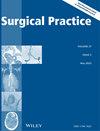sars - covv -2患者术后预后预测模型:回顾性观察研究
IF 0.2
4区 医学
Q4 SURGERY
引用次数: 0
摘要
介绍。冠状病毒感染可使任何手术干预的围手术期复杂化,对COVID-19手术患者构成急性问题。与此同时,风险因素及其对不良后果的影响仍然不清楚。本研究旨在确定SARS-CoV-2患者术后死亡的危险因素。材料和方法。该研究对克拉斯诺达尔地区第二临床医院1029名患者的数据进行了回顾性分析,该医院已被改造为COVID-19治疗机构。共有421例(41%)患者接受了高风险手术。研究队列的死亡率达到21.2%。ASA基线身体状况、年龄、手术时间和CT扫描(CT-3和CT-4)显示的肺损伤程度等因素是死亡的独立预测因素。利用这些参数可准确预测围手术期死亡率(AUROC = 0.814)。该研究调查了COVID-19手术患者预后不良的风险因素,并开发了一个预测这组患者死亡的模型。sars - cbackupv -2患者手术治疗后出现不良结果的频率相对较高,预测死亡的因素包括高龄、基线身体状况、手术严重程度和持续时间,以及CT扫描上看到的肺损伤量。开发的模型可以准确预测不利的结果。本文章由计算机程序翻译,如有差异,请以英文原文为准。
A prediction model for after postoperative outcome in SARS-CоV-2 patients: a retrospective observation study
Introduction. Coronavirus infection can complicate the perioperative course of any surgical intervention, posing an acute problem in surgical patients with COVID-19. At the same time, the risk factors and their contribution to the adverse outcome remain obscure.Objectives. This study aims to identify risk factors for postoperative death in patients diagnosed with SARS-CoV-2.Materials and methods. The study offers a retrospective analysis of data from 1029 patients at the Krasnodar Regional Clinical Hospital № 2, which had been converted into a COVID-19 treatment facility.Results. A total of 421 (41 %) patients underwent high-risk surgery. Mortality in the study cohort reached 21.2 %. Factors such as the ASA baseline physical status, age, surgery duration and the degree of lung damage seen on CT scans (CT-3 and CT-4) serve as independent predictors of death. Using these parameters makes it possible to predict perioperative mortality with high accuracy (AUROC = 0.814).Conclusion. The study examined risk factors for poor outcomes in surgery patients with COVID-19 and developed a model to predict death in this group of patients. The frequency of adverse outcomes after surgical treatment of patients with SARS-CоV-2 was relatively high, the predictors of death being advanced age, baseline physical status, surgery severity and duration, as well as the volume of lung damage seen on CT scans. The developed model allows accurate prediction of an unfavourable outcome.
求助全文
通过发布文献求助,成功后即可免费获取论文全文。
去求助
来源期刊

Surgical Practice
医学-外科
CiteScore
0.90
自引率
0.00%
发文量
74
审稿时长
>12 weeks
期刊介绍:
Surgical Practice is a peer-reviewed quarterly journal, which is dedicated to the art and science of advances in clinical practice and research in surgery. Surgical Practice publishes papers in all fields of surgery and surgery-related disciplines. It consists of sections of history, leading articles, reviews, original papers, discussion papers, education, case reports, short notes on surgical techniques and letters to the Editor.
 求助内容:
求助内容: 应助结果提醒方式:
应助结果提醒方式:


